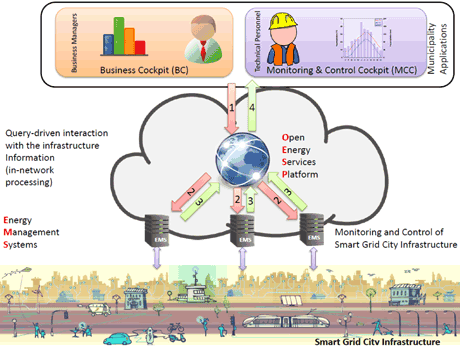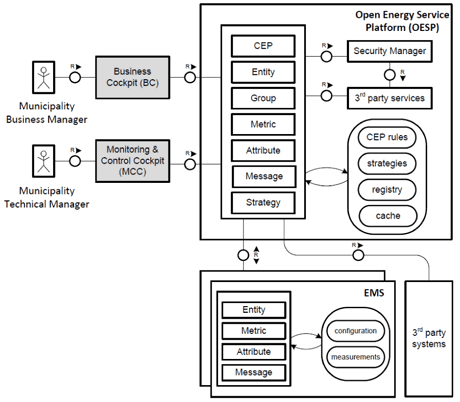by Stamatis Karnouskos
Cyber-physical systems underpin modern Smart Grids and Smart Cities. New approaches are required to enable efficient, secure and decentralized use of the huge amount of generated data in value-added applications. The SmartKYE project (www.smartkye.eu) is investigating such directions for query-driven integration of Smart Grid City Systems.
We witness a revolution that capitalizes on the prevalence of networked (embedded) devices ranging from simple ones, such as sensors, to complex Cyber-Physical Systems (CPS), in order to empower a new generation of innovative anytime-anywhere services. The CPS revolution enables system interconnection and fine-grained information acquisition at unprecedented scales. The analytics of CPS data pave the path towards informed real-time decision making in complex infrastructures. For Smart Grid Cities this implies innovative solutions [1] in energy management, sophisticated demand-response (DR) and demand-side management (DSM), optimal resource usage, reliability and security, new business opportunities etc. The Smart Grid and its services [2] are seen as an integral part of the Smart City of the future. Several ongoing efforts [1] strive towards capitalizing on the hyper-connected information infrastructure and the collaboration among the things, services, and systems expected to exist in the Smart City.
The SmartKYE project project goes beyond existing efforts towards a realistic approach for future Smart Grid Cities. Most research projects [1] that deal with aspects of energy management are still focusing on core infrastructure issues that will enable them to measure energy production and consumption and potentially manage it [3]. Some go a step further towards building analytics and value-added services based on the data acquired. Recent advances in cloud computing and high performance in-memory databases tuned for delivering timely analytics and various web tools/apps [3] empower such efforts.
One key point that may be problematic, however, is information ownership and management. Most of the approaches developed today assume usually centralized unconditional access to the data [2]. This is a valid assumption within the scope of an organization, such as an energy provider, that controls the whole value chain. However, in large-scale infrastructures multiple such stakeholders will emerge with portions of the data, and many are likely to be reluctant to share their data unconditionally since it represents a key asset and competitive advantage of an enterprise. Hence, business models need to be extended to include interactions among stakeholders that will deliver value-added services without revealing all of the data, i.e., that will reveal relevant details without handing over an enterprise’s core advantages.
The SmartKYE project capitalizes exactly on that vision. Contrary to currently overwhelmingly centralized information gathering approaches, SmartKYE considers a query-driven interaction with the vast number of stakeholders and their systems (as illustrated in Figure 1). A loosely coupled infrastructure enables stakeholders to join or leave the SmartKYE system, and the core infrastructure data may still be owned by the respective systems. To what extent and to what resolution such data is communicated to other stakeholders, depends on the queries issued and the willingness or contract-based negotiated actions. By not owning the data, and having an infrastructure that intelligently handles the communication between consumers and producers of information, scalability can be achieved, as well as coevolution at both ends. As depicted in Figure 1, several stakeholders monitor and control parts of the smart grid city infrastructure. As Figure 2 illustrates, the acquired information is gathered via various Energy Management Systems (EMS) which also host control capabilities for actuating the underlying infrastructure.


Each EMS has its own local view and can operate autonomously from the rest. In the cloud, the Open Energy Services Platform (OESP) acts as the glue among the disparate systems and the information consumers who, in our example case, are portrayed at the top as the municipal information systems. The OESP hosts several advanced functionalities including: the capability of accepting queries from the end-user applications, disaggregating them to see which EMS need to be addressed, contacting the EMS to acquire the necessary information, aggregating the answers, and delivering the information as requested. The latter is done with additional indicators on the quality of data delivered. In addition, OESP offers services via which management actions can be undertaken on the infrastructure. Finally the end-users interact via cockpits with the system. In SmartKYE, as a proof of concept, two cockpits are addressed with different contexts:
- the Business Cockpit (BC) targets the municipal administrators and decision makers who can get high-level information and can be assisted in their decision processes; and
- the Monitoring and Control Cockpit (MCC) which targets the municipality technical personnel and infrastructure technical managers, by providing them with fine-grained technical information as well as control (management) capabilities.
References:
[1] V. Giordano, A. Meletiou, C. F. Covrig, et al: “Smart Grid projects in Europe: Lessons learned and current developments 2012 update,” Joint Research Center of the European Commission, JRC79219, 2013
[2] S. Karnouskos, D. llic, P. Goncalves Da Silva: “Assessment of an Enterprise Energy Service Platform in a Smart Grid City Pilot”, in IEEE 11th International Conference on Industrial Informatics (INDIN), Bochum, Germany, 2013
[3] S. Karnouskos, P. Goncalves Da Silva, D. Ilic: “Developing a Web Application for Monitoring and Management of Smart Grid Neighborhoods”, in IEEE 11th International Conference on Industrial Informatics (INDIN), Bochum, Germany, 2013.
Link:
SmartKYE Project Web Site: http://www.smartkye.eu
Please contact:
Stamatis Karnouskos
SAP, Germany
E-mail:











